Jul 08, 2006
Emotionally aware computer
According to The Herald, Cambridge professor Peter Robinson has developed a prototype of an “emotionally aware computer” that uses a camera to capture images of the user’s face, then determines facial expressions, and infers the user’s mood.
From the report:
‘Imagine a computer that could pick the right emotional moment to sell you something,” says Peter Robinson, of Cambridge University. “Imagine a future where websites and mobile phones could read our mind and react to our moods.”
It sounds like Orwellian fiction but this week, Robinson, a professor of computer technology, unveiled a prototype for just such a “mind-reading” machine. The first emotionally aware computer is on trial at the Royal Society Festival of Science in London…Once the software is perfected, Robinson believes it will revolutionise marketing. Cameras will be on computer monitors in internet cafes and behind telescreens in bars and waiting rooms. Computers will process our image and respond with adverts that connect to how we’re feeling.
20:43 Posted in Emotional computing | Permalink | Comments (0) | Tags: emotional computing
Cognitive Computing symposium at IBM
Via Neurodudes
Recently, the Almaden Research center, part of IBM research, invited some provocative speakers for a dicussion on the topic of “Cognitive Computing”.
Powerpoint presentations and videos of the event are available online.
From the synopsis:
The 2006 Almaden Institute will focus on the theme of “Cognitive Computing” and will examine scientific and technological issues around the quest to understand how the human brain works. We will examine approaches to understanding cognition that unify neurological, biological, psychological, mathematical, computational, and information-theoretic insights. We focus on the search for global, top-down theories of cognition that are consistent with known bottom-up, neurobiological facts and serve to explain a broad range of observed cognitive phenomena. The ultimate goal is to understand how and when can we mechanize cognition.
Confirmed speakers include Toby Berger (Cornell), Gerald Edelman (The Neurosciences Institute), Joaquin Fuster (UCLA), Jeff Hawkins (Palm/Numenta), Robert Hecht-Nielsen (UCSD), Christof Koch (CalTech), Henry Markram (EPFL/BlueBrain), V. S. Ramachandran (UCSD), John Searle (UC Berkeley) and Leslie Valiant (Harvard). Confirmed panelists include: James Albus (NIST), Theodore Berger (USC), Kwabena Boahen (Stanford), Ralph Linsker (IBM), and Jerry Swartz (The Swartz Foundation).
20:38 Posted in Brain training & cognitive enhancement | Permalink | Comments (0) | Tags: cognitive computing
Jul 06, 2006
Biofeedback for neuromotor rehabilitation
Recent developments of biofeedback for neuromotor rehabilitation.
J Neuroengineering Rehabil. 2006 Jun 21;3(1):11
Authors: Huang H, Wolf SL, He J
ABSTRACT: The original use of biofeedback to train single muscle activity in static positions or movement unrelated to function did not correlate well to motor function improvements in patients with central nervous system injuries. The concept of task-oriented repetitive training suggests that biofeedback therapy should be delivered during functionally related dynamic movement to optimize motor function improvement. Current, advanced technologies facilitate the design of novel biofeedback systems that possess diverse parameters, advanced cue display, and sophisticated control systems for use in task-oriented biofeedback. In light of these advancements, this article: (1) reviews early biofeedback studies and their conclusions; (2) presents recent developments in biofeedback technologies and their applications to task-oriented biofeedback interventions; and (3) discusses considerations regarding the therapeutic system design and the clinical application of task-oriented biofeedback therapy. This review should provide a framework to further broaden the application of task-oriented biofeedback therapy in neuromotor rehabilitation.
00:20 Posted in Biofeedback & neurofeedback | Permalink | Comments (0) | Tags: biofeedback, neurofeedback
Recording of electrical activity by a multi-transistor array (MTA)
M. Hutzler, A. Lambacher, B. Eversmann, M. Jenkner, R. Thewes, and P. Fromherz
Journal of Neuropyhsiology. Preprint online (May 10, 2006).
We report on the recording of electrical activity in cultured hippocampal slices by a multi-transistor array (MTA) with 16384 elements. Time-resolved imaging is achieved with a resolution of 7.8 µm on an area of 1 mm2 at 2 kHz. A read-out of fewer elements allows an enhanced time resolution. Individual transistor signals are caused by local evoked field potentials. They agree with micropipette measurements in amplitude and shape. The spatial continuity of the records provides time-resolved images of evoked field potentials and allows the detection of functional correlations over large distances. As examples, fast propagating waves of presynaptic action potentials are recorded as well as patterns of excitatory postsynaptic potentials across and along cornu ammonis.
00:10 Posted in Neurotechnology & neuroinformatics | Permalink | Comments (0) | Tags: neurotechnology
Third International Meeting on Brain-Computer Interface Technology
00:08 Posted in Brain-computer interface | Permalink | Comments (0) | Tags: brain-computer interface
Next-generation gaming experiences
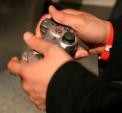
While players of video games have always been waiting for the next generation of technology, less fuss is made about next-generation experiences. If such experiences are already there, what are they like? What would be the 21st-century-equivalent to the experiences of Andy Capp's Tavern's customers who rushed into the bar to play Pong until the machine got jammed with coins? Ask a script writer, a political mod artist, a middleware developer, a computer game researcher, and someone who has traded off his social contacts in real life for a high-level character in a MMOG - and you will be overwhelmed by the diversity of what makes an experience worth striving for.
Department of Media at the Faculty of Art & Design of the University of Lapland and Mediapolis Innomedia project will publish a multidisciplinary book on player experiences in early 2007. The book will be a compilation of peer-reviewed articles. Respecting the department of Media's tradition of combining research with design, the book aims to piece together contemplations from researchers, designers, and those in-between, within or outside the academia.
On one hand, the extending might mean creating games that allow new kinds of experiences or are more emotional, maybe by implementing innovations regarding for example gameplay, graphics, sound or the interface. Also the players are creative. Their use of games in a way designers did not intend alters their experiences. On the other hand, the extending takes place concept-wise. In the wake of new forms of games and playing new types of players get introduced to digital games. Thus, the concept of player experience has to assimilate very different takes on how, where, when and why games are played and experienced. No matter from which viewpoint one looks at the player's experience, it seems that it poses challenges for those trying to observe or analyse it, not to mention those who are trying to understand it in order to be able to design something new.
Topics that the authors are invited to be address from the viewpoint of the players experience include, but are not limited to the following, and case-studies with an artistic or an industrial perspective are also welcomed.
Games
- Game genres and gameplay concepts, abstract games, story-based games
- Game design "trends", e.g. movie-like games with no HUDs
- Graphics and sound; audiovisual styles, cel-shading, photorealism, sound-based games
- Different player setups; one or many, local or online, one-vs-one, team-vs-team, etc.
- Avatars and other player representations
- Innovations; new gameplay concepts, platforms, input devices, interfaces, AI
- Different types of games; online multiplaying (both hc & casual), mobile and portable games, pervasive and VR games
- Content; games not only for entertaining, i.e. "seriousness" of games, in-game advertising
Players
- Different player groups and motivations; e.g. newbie, casual, hc, professional, senior, grrl, and mom gamers
- The role of "fun" in players' experiences
- Player identities
- Games as media for human relations
- Players' goals, emotions, motivations, expectations
- Consequences of playing
- Borderline activities; guild/clan webfora, mods, machinima, real-money trade of in-game assets
Methodological challenges for research and design
- Games as form of art, propaganda or education
- Design research from all viewpoints
- Philosophy of the experience
- Game-related experiences vs. other experiences
- Player's experience compared to user's/reader's/viewer's experience
- The applications of cognitive psychology, affective computing, HCI, Media Studies, etc. on understanding the players' experiences
IMPORTANT DATES
All papers will be reviewed by an independent review committee, which will provide written feedback on each paper. NB: Due to popular demand, the abstract submission deadline has been extended from the original.
June, 19. 2006 Abstract submission (was: June 5th)
June, 26. 2006 Notification of acceptance (was: June 12th)
Sept, 5. 2006 Submission of full papers
Jan, 10. 2006 Submission of final papers
00:04 Posted in Call for papers | Permalink | Comments (0) | Tags: emotional computing
Jul 05, 2006
Awareness and Accountability in MM Online Worlds
Doing Virtually Nothing: Awareness and Accountability in Massively Multiplayer Online Worlds
Robert J. Moore , Nicolas Ducheneaut and Eric Nickell.
To date the most popular and sophisticated types of virtual worlds can be found in the area of video gaming, especially in the genre of Massively Multiplayer Online Role Playing Games (MMORPG). Game developers have made great strides in achieving game worlds that look and feel increasingly realistic. However, despite these achievements in the visual realism of virtual game worlds, they are much less sophisticated when it comes to modeling face-to-face interaction. In face-to-face, ordinary social activities are "accountable," that is, people use a variety of kinds of observational information about what others are doing in order to make sense of others' actions and to tightly coordinate their own actions with others. Such information includes: (1) the real-time unfolding of turns-at-talk; (2) the observability of embodied activities; and (3) the direction of eye gaze for the purpose of gesturing. But despite the fact that today's games provide virtual bodies, or "avatars," for players to control, these avatars display much less information about players' current state than real bodies do. In this paper, we discuss the impact of the lack of each type of information on players' ability to tightly coordinate their activities and offer guidelines for improving coordination and, ultimately, the players' social experience.
23:43 Posted in Telepresence & virtual presence | Permalink | Comments (0) | Tags: social presence
Panasonic Emotions Testing Line
Re-blogged from Networked Performance
The Panasonic Emotions Testing Line, by "nomadic" development designer JIŘÍ ČERNICKÝ, is a conceptual SD audio-prosthesis that aims to grasp the issue of the emotional deficits in society.
The device is a substitute, personal container for the emotions of users who are not able, or do not want, to experience life through their own emotional perceptions. It looks like a Walkman-type device with headphones that does not play music inside, but rather outside, of the head. The device facilitates the user's emotional communication with the world around him. It is not designed for his/her personal use only but is equipped with a tiny amplifier.
The memory of the SD Audio Player chip card contains a great amount of data containing recordings of authentic human emotions. For instance, if the user finds himself in a situation where he has to argue with someone, yet he does not want to get into confrontation and to waste his own emotions, he locates a password on his SD Audio Player representing an appropriate emotional response, which he then applies accordingly.
The SD Audio Player can also record and thus appropriate other people's emotions: sniveling, peevishness, sobbing, moaning, crying, gradual emotional collapse, breakdown, yelling by a beaten person, the state of mind between laughter and crying, the hysterical family argument from Fellini's film Amarcord, pubescent giggling, comforting and fondling of a baby, a feeling of well-being, enthusiastic effusions, wearing somebody out, cuddling, soothing, etc. Such recordings, including those from movies, can be further edited and modified on a computer. In this way, the user can appropriate the emotions that are conveyed by celebrities and other prominent individuals.
23:35 Posted in Emotional computing | Permalink | Comments (0) | Tags: emotional computing
Handheld Augmented Reality
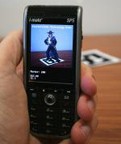 Handheld Augmented Reality: A standard, off-the-shelf Personal Digital Assistant (PDA) constitutes a cost-effective and lightweight hardware platform for Augmented Reality (AR). A PDA provides a simple, well-known user interface, and is fully equipped with a touch-screen and camera for providing a video see-through Magic Lens metaphor of interaction. In our Handheld AR framework, all interactive processing is done exclusively on the PDA without relying on a server infrastructure, which makes this solution highly scalable. Because of the low cost and suitable ergonomic properties of the PDA platform, massive multi-user AR application become possible for the first time.
Handheld Augmented Reality: A standard, off-the-shelf Personal Digital Assistant (PDA) constitutes a cost-effective and lightweight hardware platform for Augmented Reality (AR). A PDA provides a simple, well-known user interface, and is fully equipped with a touch-screen and camera for providing a video see-through Magic Lens metaphor of interaction. In our Handheld AR framework, all interactive processing is done exclusively on the PDA without relying on a server infrastructure, which makes this solution highly scalable. Because of the low cost and suitable ergonomic properties of the PDA platform, massive multi-user AR application become possible for the first time.23:32 Posted in Augmented/mixed reality, Wearable & mobile | Permalink | Comments (0) | Tags: augmented reality
The MagicBook
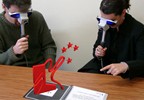
The MagicBook explores seamless transition between reality and virtual reality. When users look at the pages of a real book through a hand held display, they are able to see virtual content superimposed over the real pages, that is augmented reality. When they see an augmented reality scene they like, users can fly into the scene and experience it as an immersive virtual environment. Currently the user can transition smoothly between these two fixed viewing modes: the augmented-reality view and the virtual-reality view.
23:29 Posted in Augmented/mixed reality | Permalink | Comments (0) | Tags: augmented reality
Hearing with Your Eyes
Via Medgadget
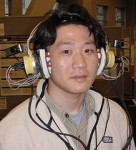
Manabe Hiroyuki has developed a machine that could eventually allow you to control things in your environment simply by looking at it. From the abstract:
A headphone-type gaze detector for a full-time wearable interface is proposed. It uses a Kalman filter to analyze multiple channels of EOG signals measured at the locations of headphone cushions to estimate gaze direction. Evaluations show that the average estimation error is 4.4® (horizontal) and 8.3® (vertical), and that the drift is suppressed to the same level as in ordinary EOG. The method is especially robust against signal anomalies. Selecting a real object from among many surrounding ones is one possible application of this headphone gaze detector. Soon we'll be able to turn on the Barry Manilow and turn down the lights with a simple sexy stare.
23:17 Posted in Future interfaces | Permalink | Comments (0) | Tags: future interfaces
Jul 04, 2006
Blind Reader
Via KurzweilAI.net (press release)
The National Federation of the Blind (NFB) unveiled Monday a groundbreaking new device, the Kurzweil-National Federation of the Blind Reader.
The portable Reader, developed by the National Federation of the Blind and renowned inventor Ray Kurzweil, enables users to take pictures of and read most printed materials at the click of a button. Users merely hold "the camera that talks" over print -- a letter, bills, a restaurant menu, an airline ticket, a business card, or an office memo --- to hear the contents of the printed document played back in clear synthetic speech.
Combining a state-of-the-art digital camera with a powerful personal data assistant, the Reader puts the best available character-recognition software together with text-to-speech conversion technology in a single handheld device.
"I've worked on reading machines for the blind and with the National Federation of the Blind for over thirty years, and this has been the most rewarding experience I've had as an inventor," said Ray Kurzweil, who was the chief developer of the first omni-font optical character-recognition technology, the first print-to-speech reading machine for the blind, the first CCD flatbed scanner, the first text-to-speech synthesizer, and the first commercially marketed, large-vocabulary speech recognition engine.
"I have always said that the most exciting aspect of being an inventor is to experience the leap from dry formulas on a blackboard to actual improvements in people's lives, and I've had the reward of that experience with this project.
This is basically a software invention, he explained. "In addition to squeezing omni-font optical character recognition and text-to-speech synthesis into a pocket sized computer, we had to develop intelligent image enhancement software that could clean up the images of print received from a digital camera. Unlike the images produced by a flatbed scanner, images from a digital camera are subject to rotation, tilt, curvature, uneven illumination and other distortions. The image enhancement software we developed automatically corrects for these problems.
"Because this is a software based technology, our users will be able to benefit from the futurefuture, we envision the reader being able to identify real-world objects, and even people's faces. So, for example, the product may tell you that there is a cat in front of you, a lamp to your left, and sitting to your right is your ex-wife.'" improvements we make. In the
00:05 Posted in Brain training & cognitive enhancement | Permalink | Comments (0) | Tags: cognitive prosthetic
Jul 03, 2006
Wish progress bar
the "wish project bar" is a tool which measures long-term goals or whishes, as it creates an emotional link to the passing of time. the progress bar runs for 18 years with each band represents 1 year, serving as a gentle reminder & requiring very little attention. Users can make a wish, set the time by turning the top cap & then leave to do its thing.
23:56 Posted in Emotional computing | Permalink | Comments (0)
Navigated brain stimulation
Via Emerging Technology Trends
A young Finnish company, Nexstim, has developed a non-invasive brain scanning and stimulation system called navigated brain stimulation (NBS). This system is already in use in 20 hospitals worldwide.
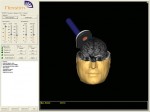
From the company's website:
Medical professionals have always dreamt of the ability to actively reach into the brain - touch instead of looking. Modern brain scanners, such as MRI, already offer sophisticated views into the human brain. Yet, these images are passive views of structures.
Nexstim's Navigated Brain Stimulation (NBS) system reaches actively into the brain. NBS guides the precise delivery of targeted transcranial magnetic stimulation (TMS) pulses to discrete brain areas. The eXimia NBS system is the only device available for accurate prediction of the TMS stimulus location and dose within the human brain.
The safe and non-invasive mapping using eXimia NBS can support neurologists and neurosurgeons to diagnoze and treat the human brain diseases, trauma, and dysfunctions.
The earliest possible diagnosis of neuronal disorders rely on detection of functional changes with active, interventive tools such as NBS.

23:52 Posted in Neurotechnology & neuroinformatics | Permalink | Comments (0) | Tags: neuroinformatics
New device for reproducing smells
Via Cognitive Daily
A team of researchers in Japan has built a device that is capable of reproducing an impressively large array of smells, says a report in New Scientist.
The system will use 15 chemical-sensing microchips, or electronic noses, to pick up a broad range of aromas. These are then used to create a digital recipe from a set of 96 chemicals that can be chosen according to the purpose of each individual gadget. When you want to replay a smell, drops from the relevant vials are mixed, heated and vaporised. In tests so far, the system has successfully recorded and reproduced the smell of orange, lemon, apple, banana and melon. "We can even tell a green apple from a red apple," Team member Pambuk Somboon says.
23:43 Posted in Virtual worlds | Permalink | Comments (0)
Cell phone emissions excite the brain cortex
More than 500 million people in the world use cell phones which emit electromagnetic fields (EMFs). Though many studies have looked at the effects of EMFs on the body, few have focused on their effects on the brain. Such effects could be harmful, neutral, or beneficial and might be particularly important for individuals with conditions involving cortical excitability, such as epilepsy.
Researchers in Italy, led by Paolo M. Rossini, M.D., Ph.D. of Fatebenefratelli, used Transcranial Magnetic Stimulation (TMS) to investigate brain function under exposure to electromagnetic fields from a common type of cell phone. Their study reports the effects of EMF exposure on brain physiology for the first time.
The researchers developed a double-blind study in which 15 young male volunteers were exposed to EMF signals from a GSM 900 cell phone for 45 minutes. They measured Motor Evoked Potentials (MEPs) during motor cortex TMS before, and immediately after EMF exposure, and also one hour later.
In 12 of the 15 subjects, the data showed an excitability change in the motor cortex adjacent to the cell phone. "Intracortical excitability was significantly modified, short intracortical inhibition was reduced and facilitation enhanced," the authors report. They found that the effects of the EMF were transient and the subjects' brains tended to return toward baseline conditions one hour after the exposure.
It would be premature to presume that this work implies that using a cell phone is bad for the brain in any way. Much more work needs to be done to understand whether these electrical changes in the brain make any difference whatsoever in the way we think or in any disease process in which cortical excitability is affected.
Article: "Mobile phone emissions and human brain excitability." Ferreri, Florinda; Curcio, Giuseppe; Pasqualetti, Patrizio; De Gennaro, Luigi; Fini, Rita; Rossini, Paolo. Annals of Neurology; July 2006; (DOI: 10.1002/ana.20906 ).
Objective |
To test - via Transcranial Magnetic Stimulation (TMS) - the excitability of each brain hemisphere after  real real or or  sham sham exposure to the electromagnetic field (EMF) generated by a mobile phone operating in the Global System for Mobile Communication (GSM). exposure to the electromagnetic field (EMF) generated by a mobile phone operating in the Global System for Mobile Communication (GSM). |
Methods |
| Fifteen male volunteers attended two experimental sessions, one week apart, in a cross-over, double-blind paradigm. In one session the signal was turned ON (EMF-on, real exposure), in the other it was turned OFF (EMF-off, sham exposure), for 45 minutes. Motor Evoked Potentials (MEPs) were recorded using a paired-pulse paradigm (testing intracortical excitability with 1 to 17 ms interstimulus intervals), both before and at different times after exposure to the EMF. Short Intracortical Inhibition (SICI) and Facilitation (ICF) curves were evaluated both on the exposed and non-exposed hemispheres. Tympanic temperature was collected during each session. |
Results |
| The intracortical excitability curve becomes significantly modified during real exposure, with SICI being reduced and ICF enhanced in the acutely exposed brain hemisphere as compared to the contralateral, non-exposed hemisphere or to sham exposure. Tympanic temperature showed no significant main effect or interactions. |
23:39 Posted in Wearable & mobile | Permalink | Comments (0) | Tags: mobile phones
Ethics of Persuasive Technology
BJ Fogg has posted to his blog "Captology Notebook" an unpublished article on the ethics of persuasive technology that is really worth reading...
ANALYZING THE ETHICS OF PERSUASIVE TECHNOLOGY
2005
DANIEL BERDICHEVSKY
B.J. FOGG
RAMIT SETHI
MANU KUMAR
Stanford Persuasive Technology Lab
Authors' addresses: Daniel Berdichevsky, 1006 Wall St. Los Angeles, CA 90015; B.J. Fogg, Ramit Sethi and Manu Kumar, Persuasive Technology Lab, Stanford University, Box 20456, Stanford, CA 94309
________________________________________________________________________
1. INTRODUCTION
When a doctor tells you your blood pressure is too high, you may modify your lifestyle to compensate: less salt, more exercise, fewer freedom fries. In a sense, the doctor has committed a persuasive act. We are unlikely to question the ethics of her having done so. But what if the doctor were out of the picture? Suppose a device at your bedside not only informed you of your blood pressure each morning, but shifted colors to convey the likelihood of your suffering a heart attack. Would such a persuasive technology be as ethical as a doctor giving you advice in her office? What if it were co-marketed with a treadmill?
The objective of this article is to describe and test a framework for analyzing the ethics of technologies that change people’s attitudes and behaviors. We focus on computerized persuasive technologies—the field known as “captology”—though similar considerations apply to non-computerized technologies, and even to technologies that change attitudes and behaviors by accident.
This idea of unintended persuasive outcomes is one reason we are revisiting this topic four years after the publication of an earlier piece by one of the authors, “Toward an Ethics of Persuasive Technology.” [Berdichevsky & Neuenschwander, 1999] Since 1999, persuasive elements have become common enough in both hardware and software—and especially on the web—that designers may not always be conscious of their persuasive nature. They may take them for granted. This telephone beeps to remind you to check your voice mail; that search engine changes its logo every day in a continuing narrative to pull you back more often . But even when persuasion is incidental to other design motives, it requires ethical attention—particularly because end users may not be expecting it and are therefore caught with their defenses down. [Fogg, 2002]
Why pay special attention to computerized persuasive technologies? The chief reason is that while non-computerized technologies can certainly be persuasive, only rarely can they stand on their own . A television with no infomercial to display will not convince you to buy new cutlery. A whip without someone to wield it will cow no slave into obedience. Even a carpool lane requires enforcement.
What makes computerized persuasive technologies more interesting than these examples is that they can persuade independently. Computerized persuasive technologies are also dynamic, changing in response to different users and their inputs. They allow persuasion—and the persuasive experience—to be simultaneously mass-manufactured and user-specific. For instance, a wristwatch that encourages you to keep running by congratulating you on the specific number of calories you have burned is completely self-contained. This leads to questions of agency: do you blame the wristwatch if a runner suffers a heart attack trying to achieve a certain pulse?
The full article can be accessed here
23:25 Posted in Persuasive technology | Permalink | Comments (0) | Tags: persuasive technology
Brain waves allows disabled to take a virtual stroll
From The Observer
A new 'virtual helmet' which harnesses the power of brain waves is allowing severely disabled people to feel as if they can walk and move again, opening up the prospect of using the mind to help them control wheelchairs, computers and even false limbs.
Just by imagining their feet moving, patients using wheelchairs can again experience what it feels like to stroll down a high street, thanks to the work of British scientists who have found a new way of using the power of thought. They have devised the helmet which can link brain wave patterns to a virtual reality system, allowing the wearer to enter an illusory world of movement.
The new system has been tried out for the first time by an Austrian man who became a paraplegic after a swimming accident. Tom Schweiger was injured on holiday in Greece seven years ago when a huge wave swept him on to rocks, severing the spinal cord in his neck and leaving him paralysed apart from some movement in his left arm.
Last week 31-year-old Schweiger was able to enter a different virtual world when the scientists from his home country and a team at University College London tested the new system. When he was asked by researchers to think about moving either his foot or his hand, the changes in his brain waves - or electroencephalogram (EEG) signals - were recorded by electrodes on the top of his head. These were then turned into a control signal which was linked up to the virtual reality system.
Schweiger was given special 3D glasses to wear so that the images created in the 'virtual cave' created for the experiment, made up of a four-sided room complete with stereo sound and projected images, gave him the illusion of walking through a street. Different characters appeared on the screen and talked to him and he was asked to respond...
Read the full article
18:05 Posted in Brain-computer interface | Permalink | Comments (0)










